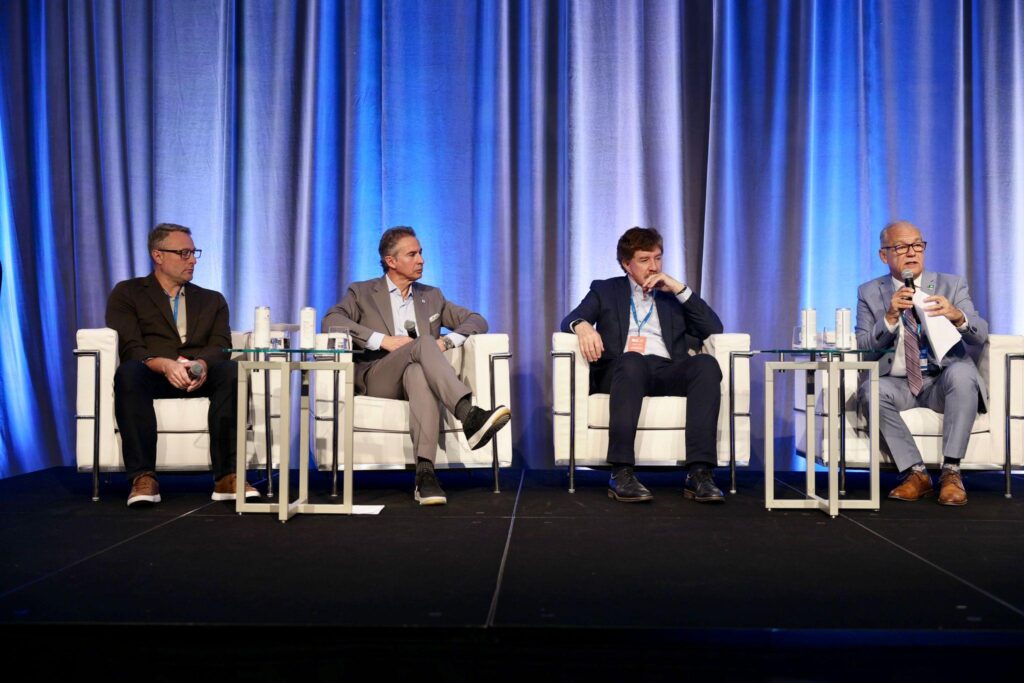Stay calm and decarb on
CBRE’s Paul Morassutti offers a steady read on market trends and a reminder that sustainable real estate is still the smartest long-term play.
- Theme
- Green Building
In a market where headwinds make headlines, Paul Morassutti delivered something different at Building Lasting ChangeTM (BLC)—a keynote grounded in clarity, context, and the long view. The event, hosted this year in Vancouver by the Canada Green Building Council (CAGBC), drew leaders from across the building sector.
Drawing from decades of experience in commercial real estate and land development, Morassutti began with a wide-angle view of shifting market sentiment. “Not that long ago, many proclaimed the retail market to be dead, and then it was the office market that was supposed to be dead, and now ESG,” he said.
Not so, he argued. Contrary to these proclamations, office real estate is far from finished. To illustrate this, he pointed to concrete signs of resilience—most notably, new data showing that Vancouver now holds the lowest downtown office vacancy rate in North America, defying the narrative of permanent decline.
Rather than sounding the alarm, Morassutti encouraged attendees to accept these ebbs and flows are all part of the journey—a reminder that disruption doesn’t always signal demise, but often, evolution.
Staying competitive means looking ahead
He acknowledged that sustainability may feel sidelined at the moment, especially amid growing anti-ESG sentiment south of the border. As he put it, the industry is in a “hunker-down mentality”—focused more on survival than transformation.
But, Morassutti warned, short-term uncertainty shouldn’t distract from long-term value. “Most people ask me about the value of being green,” he said. “In my opinion, adopting a sustainability strategy is more about protecting downside and ensuring that an asset will be competitive for years rather than a tangible premium in price.”
He identified embodied carbon—emissions associated with construction materials and processes—as a critical next frontier. He cited Hines’ 27 mass timber office projects, including two in Toronto and one in Vancouver, as well as Prologis’ newly completed mass timber distribution facility in Toronto, as signs that innovation is already happening.
Still, he emphasized that more must be done to build awareness and understanding of embodied carbon—a gap that the CAGBC is working to close through education, advocacy, and industry engagement.

New valuation pact aims to shift market incentives
Following the keynote, a panel discussion brought together Morassutti with industry leaders Michael Brooks (REALPAC), Jonas Locke (Altus Group), and Thomas Mueller (CAGBC). Together, they explored how better data, education, and collaboration can help accelerate the shift to greener, more resilient buildings.
The panel also served as the launchpad for a major new initiative: REALPAC and CAGBC are partnering with leading valuation firms to develop standardized approaches to green valuation in Canadian real estate.
More than a technical fix, the initiative tackles one of the biggest barriers identified in Decarbonizing Canada’s Commercial Buildings: The Owner & Investor Perspective, a recently published report by REALPAC, CAGBC, and the PLACE Centre at the Smart Prosperity Institute. One of its ten recommendations calls for properly valuing decarbonized assets, noting that premiums for low-carbon buildings often go unrecognized in current appraisal models and balance sheets.
“This initiative strengthens the business for case for green building investments,” said Mueller after the announcement. “When investors can clearly see the value of decarbonization reflected in appraisals, they’re far more likely to act. Aligning valuation with measurable sustainability outcomes is a necessary step if we want to scale investment in low-carbon buildings.”

What’s next—and a reminder not to wait
The next step for the newly formed valuation pact is the October roundtable in Toronto,
but the broader message from the BLC panel was that the time to act is now.
As Morassutti pointed out during his presentation, climate waits for no one. “Mother Nature could not care less about our political squabbles,” he noted. “If you look at the severity of global risks over the next 10 years, the picture is pretty stark. We better start paying attention.”
Yet, his message was not one of despair—it was about momentum. Even amid disruption, there is opportunity. Sustainability strategies and smart investment are not mutually exclusive; in fact, they go hand in hand.
In closing, Morassutti offered the packed plenary session a compelling call to rethink the status quo: “Everyone in the industry needs to stop this practice of looking at the world as it is right now and assuming that’s the way it’s always going to be.”
To drive home his point, he posed this pointed question to the real estate and development community: Ten years from now, do you think there will be more or fewer tenants demanding greener, energy efficient buildings?
The answer, he suggested, is obvious.
“To me the issue is not, ‘well today, there’s only a certain percentage of tenants for whom a net zero commitment is really important,’” he said. “The important thing to me is that percentage is growing every year. And if you ignore that, you ignore it at your own peril.”